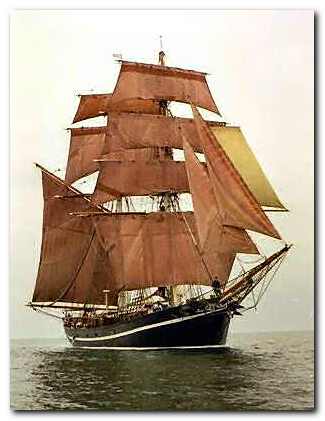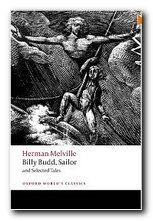tutorial, commentary, study resources, and web links
Billy Budd is the last (and uncompleted) prose work of Herman Melville. In 1856, disenchanted with the sales and critical reception of his novels, he gave up writing fiction and turned instead to poetry (just as Thomas Hardy was to do fifty years later, for slightly different reasons). Melville became, in the words of Robert Milder, ‘a major nineteenth-century poet and a chronicler of the Victorian crisis of belief to be set alongside Arnold, Tennyson, and Browning’. And yet towards the end of his life it was a concentrated prose narrative to which he returned, writing and re-writing Billy Budd, Sailor so many times it was 1962 before the complete and authoritative version of his text could be assembled for publication.

Billy Budd – critical commentary
The text
Billy Budd was started in 1888 and left unfinished by Melville at his death in 1891. In fact the manuscript wasn’t discovered until 1924 by Raymond. Weaver who was working on papers for the Constable edition of Melville’s Complete Works, Then in 1948 a new revised version appeared, and in 1962 there was a complete re-examination of the materials to produce what is now regarded as the definitive text, complete with its full title – Billy Budd, Sailor: An Inside Narrative.
The Novella
The narrative is about 25,000 words long; and it could be regarded as a long short story – but it is almost universally recognised as a novella – because it fulfils many of the criteria for being classed as such. These are mainly a tight focus on unity of time, place, action, and character.
Unity of place
Apart from the opening sections meditating on mutinies and recounting Billy’s transfer from the Rights of Man, almost the whole of the story takes place in one location – on board the Bellipotent.
Unity of action
Once Billy is on board the Bellipotent the essential drama of the story unfolds in more or less one continuous movement. The action of the story is concentrated in an almost Aristotelian manner to produce a single narrative arc. Billy arrives on board, Claggart denounces him, and Vere condemns him to death. Apart from Melville’s quasi-philosophic meditations on the themes of his story, there are no other issues or sub-plots in the narrative.
Unity of atmosphere
The whole of the story takes place against a backdrop of the absolute nature of naval law and the threat of mutiny against its injustices. Melville meditates on two famous episodes in naval history – the revolts at Spithead and the Nore in 1897, the latter of which resulted in hanging of twenty-nine leaders.
Vere faces a moral dilemma as captain of the ship and arbiter of justice, but he evades the moral ambiguities of his position by reverting to a crude interpretation of traditional maritime law. ‘The father in him, manifested towards Billy thus far in the scene, was replaced by the military disciplinarian’. Even before he summons the drumhead court he declares ‘Struck dead by an angel of God! Yet the angel must hang!’
Unity of character
There are a number of minor named characters in the story – but essentially the whole drama is focused on three people – Captain Vere, John Claggart, and Billy Budd.
Captain Vere is kind-hearted and well disposed towards Billy, but when confronted with a choice between humane compassion and the military rule of law, he chooses the latter. He is known as ‘Starry Vere’ because of his dreamy disposition; he is an intellectual, an aristocrat; and as a ship’s captain he has absolute rule. He is therefore in a God-like position of authority over the entire crew.
The text makes it clear that he has the option to delay any proceedings against Billy until rejoining the squadron and reporting the incident to the admiral of the fleet. The senior officers on board agree that this would be the right course of action. But Vere opts for the crude absolute rule of law – and thus precipitates the tragedy.
John Claggart is the embodiment of ‘depravity according to nature’. He encounters Billy, and as his absolute antithesis, immediately takes against him. He accuses him of the worst possible crime in the naval rule book – fomenting mutiny.
Billy is innocent, naively good, young, untainted, and blessed with good looks and a disposition that makes him popular. He is therefore a target of envy to the malicious Claggart. An older, more experienced sailor such as the Dansker knows that such opposing natures will attract each other.
The three characters are locked into an unholy alliance. The spirits of Good and Evil have a God-like character wielding absolute power of decision over their conflict, and the tragedy is precipitated by Vere’s inability to make sufficiently subtle distinctions.
It is easy to see why so many critics have explored the biblical parallels – with Vere the father or God-like figure who has the Satan-like figure of evil present in his sadistic master-at-arms, Claggart. And Billy, the innocent Adam-like figure, must be punished for his transgression of the absolute laws which Vere represents.
Billy Budd – study resources
![]() Billy Budd – Oxford World Classics edition
Billy Budd – Oxford World Classics edition
![]() Billy Budd – Dover Thrift edition
Billy Budd – Dover Thrift edition
![]() Billy Budd – Penguin Classics edition
Billy Budd – Penguin Classics edition
![]() Billy Budd – Norton Critical Editions
Billy Budd – Norton Critical Editions
![]() Billy Budd – free eBook formats at Project Gutenberg
Billy Budd – free eBook formats at Project Gutenberg
![]() Billy Budd – free audioBook version at Project Gutenberg
Billy Budd – free audioBook version at Project Gutenberg
![]() Billy Budd – Kindle eBook edition
Billy Budd – Kindle eBook edition
![]() Billy Budd – Unabridged audio download
Billy Budd – Unabridged audio download
Billy Budd – film trailer
Peter Ustinov, Terence Stamp and Robert Ryan (1962)
Billy Budd – plot summary
 William (Billy) Budd is a handsome and popular young sailor, serving on a merchant ship The Rights of Man. He a great favourite of his ship’s master, Captain Graveling. In 1897 however, Billy is impressed into service on the HMS Bellipotent which is commanded by the aristocratic Edward Fairfax (‘Starry’) Vere. Billy is a figure of innocence and good nature. He is an illiterate foundling (an abandoned and presumably illegitimate child) and is popular with other crew members. But the ship’s master-at-arms John Claggart is fuelled by a malevolent impulse to harm Billy. He reports him to the captain, falsely accusing him of fomenting a mutiny.
William (Billy) Budd is a handsome and popular young sailor, serving on a merchant ship The Rights of Man. He a great favourite of his ship’s master, Captain Graveling. In 1897 however, Billy is impressed into service on the HMS Bellipotent which is commanded by the aristocratic Edward Fairfax (‘Starry’) Vere. Billy is a figure of innocence and good nature. He is an illiterate foundling (an abandoned and presumably illegitimate child) and is popular with other crew members. But the ship’s master-at-arms John Claggart is fuelled by a malevolent impulse to harm Billy. He reports him to the captain, falsely accusing him of fomenting a mutiny.
When the Captain confronts Billy in front of his accuser and asks for an explanation, Billy becomes tongue-tied. He strikes Claggart with a blow that kills him. Although Captain Vere is well disposed towards Billy, he feels he must uphold the rules of military discipline.
A hurried drumhead ‘court’ is summoned and Vere more or less prejudges its conclusions. Billy is found guilty of assaulting a superior officer, and condemned to death. He is hanged the next morning.
Principal characters
| William (Billy) Budd | a 21 year old ‘Handsome Sailor’, |
| Captain Graveling | the commander of the Rights-ofMan |
| Edward Fairfax Vere | the commander of HMS Bellipotent |
| John Claggart | master-at-arms on the Bellipotent |
| Dansker | veteran Danish sailor |
Billy Budd – complete opera version
Benjamin Britain (1951)
Further reading
John Bryant (ed), A Companion to Melville Studies, Westport, Conn: Greenwood, 1986.
Robert E. Burkholder, Critical Essays on Melville’s ‘Billy Budd’, Boston: G.K. Hall, 1992.
Andrew Delbanco, Melville: His World and Work, New York: Random House, 2006.
William B. Dillingham, Melville’s Short Fiction 1853-1856, Athens: University of Georgia Press, 1977.
Marvin Fisher, Going Under: Melville’s Short Fiction and American 1850s, Baton Rouge: Louisiana State University Press, 1977.
Richard Harter Fogle, Melville’s Shorter Tales, Norman: University of Oklahoma Press, 1960.
Kevin J. Haynes, The Cambridge Introduction to Herman Melville, Cambridge: Cambridge University Press, 2007
Carolyn L. Karcher, Shadow Over the Promised Land: Slavery, Race, and Violence in Melville’s America, Baton Rouge: Louisiana State University Press, 1980
Robert S. Levine, Conspiracy and Romance, Cambridge: Cambridge University Press, 1989.
Robert Milder, Exiled Royalties: Melville and the Life We Imagine, New York: Oxford University Press, 2009.
Lea Bertani Vozar Newman, A Reader’s Guide to the Short Stories of Herman Melville, Boston: G.K. Hall, 1986.
Elizabeth Schultz, Melville & Woman, Ohio: Kent State University Press, 2006
© Roy Johnson 2011